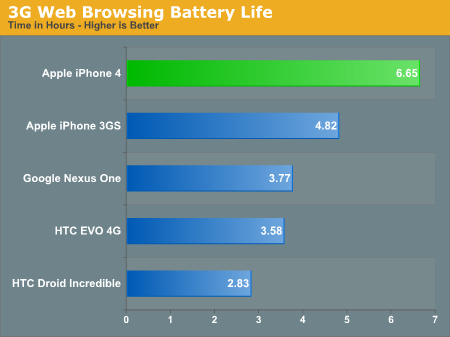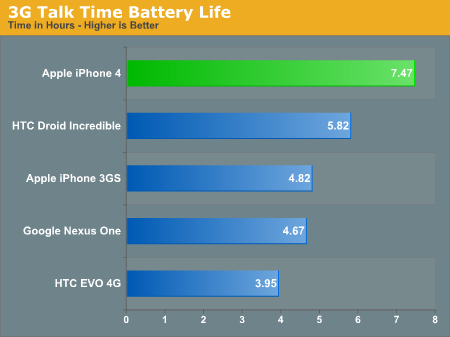Apple's iPhone 4: Thoroughly Reviewed
by Brian Klug & Anand Lal Shimpi on June 30, 2010 4:06 AM EST- Posted in
- Smartphones
- Apple
- iPhone 4
- Gadgets
- Mobile
Incredible Battery Life
I’ve publicly praised Apple for its honesty in reporting battery life over the past couple of years, and the iPhone 4 gives me no reason to stop.
The 4 has an integrated 5.25Whr battery. That’s around 95% of the battery capacity of the HTC EVO 4G, despite having much lower power frequirements. It’s also a 16% increase over the 4.51Whr battery that was in the iPhone 3GS. This means at bare minimum, assuming the iPhone 4 doesn’t draw any more power than the 3GS, we should get 16% more battery life.
In reality, we get much more.
When Apple introduced the iPhone 3G it dropped battery life to a level that we’d been stuck at ever since. The 3GS improved battery life a bit through better CPU power efficiency but you still didn’t have enough juice to get through a day without charging.
The iPhone 4 changes all of that. The combination of a larger battery and a more power efficient SoC results in an incredible amount of battery life.
Our first test is a basic web browsing benchmark. We've scripted almost two dozen webpages to load, pause for 20 seconds, then forward on to the next page. None of the pages use any Flash. This process repeats until the battery is dead. Screen brightness on the iPhones was set to 50% and the screens remained on the whole time.

Battery life improved nearly 38% with the iPhone 4. It's clear that while the A4 improved performance, the real improvement was in battery life. This test has enough idle time where good power management and low idle power can really impact the results. There's simply no other similar smartphone that can touch the 4's battery life.
We then repeated the same test over WiFi instead of 3G:

Apple claims the iPhone 4 will last for up to 10 hours over WiFi, we measured just under that at 9.96 hours. The improvement here is only 12.8%, which tells me that we're nearing the limit of how efficiently Apple can manage power in WiFi mode. There's a wall that we're quickly approaching with this current architecture.
To measure talk time we play MP3s on repeat into the mic of a phone and use it to call the phone being tested. The process continues until the test phone dies. In this case the screen is allowed to go to sleep, as it normally would be if you were talking on the phone:

Apple promised up to 7 hours of 3G talk time with the iPhone 4. We measured 7.47 hours. That's an increase of 54.9% over the iPhone 3GS. While in a phone call the majority of the A4 SoC is powered down, so the efficiency improvements here have to do with how much less power the A4 consumes while off and the new Skyworks 3G modem (the iPhone 3GS used an Infineon modem).
In our iOS 4 review we looked at the impact multitasking had on the iPhone 3GS' web browsing battery life. I ran our 3G web browsing test while playing music through Pandora in the background. I repeated the test with the iPhone 4 for today's article:

We actually see our largest battery life improvement in this test. With a 57.7% increase in battery life over the 3GS, the iPhone 4 is not only more efficient at idle workloads but also when the SoC is constantly busy. The A4 SoC is rumored to be built on a 45nm process compared to the 65nm SoC used in the 3GS. With a moderate increase in clock speed we should be seeing a lot of the power savings that a full node shrink brings to the table.
The battery life offered by the iPhone 4 is spectacular. My iPhone 3GS could hardly get through a full day of work while traveling, I'd always need to hunt for an outlet before heading into my dinner meeting. I'm about to take my first trip with the iPhone 4 but I get the feeling that I might finally be able to make it through dinner.
Early reports of 20 and 30 hours of battery life are simply exaggerated. They're only possible if you let the phone idle in your pocket for the majority of that time. In other words, if you don't use the phone it lasts for a long time. While that's a testament to the platform's incredible idle power, the real world usage is good enough to stand on its own. It's better than any iPhone or Android phone I've tested thus far.










270 Comments
View All Comments
Charlie22911 - Wednesday, June 30, 2010 - link
The EVO does not really bring anything new over previous highend phones like the HD2, Droid, or Nexus One aside from the front camera. Android phones are a dime a dozen.- Former Droid owner
JAS - Wednesday, June 30, 2010 - link
Had AnandTech's review concluded that the iPhone 4 is a terrible product, would you complain that the reviewers have a bias *against* Apple?I've read the review a couple times and see it as nothing but fair.
g5isalive - Wednesday, June 30, 2010 - link
I registered just to thank you for finally getting to the meat of the iPhone reception issue. Absolutely the best evaluation I have read.k.alexander - Wednesday, June 30, 2010 - link
Hear, hear! I did the same. I have not read through the full review, but the page on the antennae issue is by far the most thorough and thoughtful think I've seen from looking all over the web. Great Great Work!mczak - Wednesday, June 30, 2010 - link
Looks like a glaring omission, however I'm not convinced yet it would actually improve matters a lot. The bumper case not only insulates but also adds distance between your fingers and the antenna.I think it would be an interesting experiment to actually try this out, with some duct tape as insulative coating for instance...
btw I think that bumper case is _vastly_ overpriced. For that price I'd expect it would at least properly work with the dock connector, but as is that's not really good value...
kmmatney - Wednesday, June 30, 2010 - link
It works with an "Apple" dock connector - just not with third party connectors that make the connector too large. I'd probably just file down my cheap third party connectors before paying for an overpriced Apple accessory.MurderMostFowl - Wednesday, June 30, 2010 - link
In the signal Attenuation chart.... Is that iPhone 3GS "open palm" figure correct? 0.2 dB... I would think that kind of reception wouldn't be possible. since it is better than the other two devices by a massive amount ( remember dB is not linear )it must be an error, no?
eyk03 - Wednesday, June 30, 2010 - link
This review is just phenomenal, I love it. So much more objective and in-depth than the 27 word reviews that Walt Mossberg or David Pogue deign to fart out.spunkybart - Wednesday, June 30, 2010 - link
Finally someone sits down and does some tests!I love, love your use of the Star Trek "ugly bags of mostly water" line, lol!
I found it very interesting that your first thought was that the external antenna should have been coated -- that could have been a very easy thing to have done during manufacturing, so it sounds like Apple totally messed up on that decision!
InterHmai - Wednesday, June 30, 2010 - link
This was an incredibly well detailed review, thanks for all the hard work!